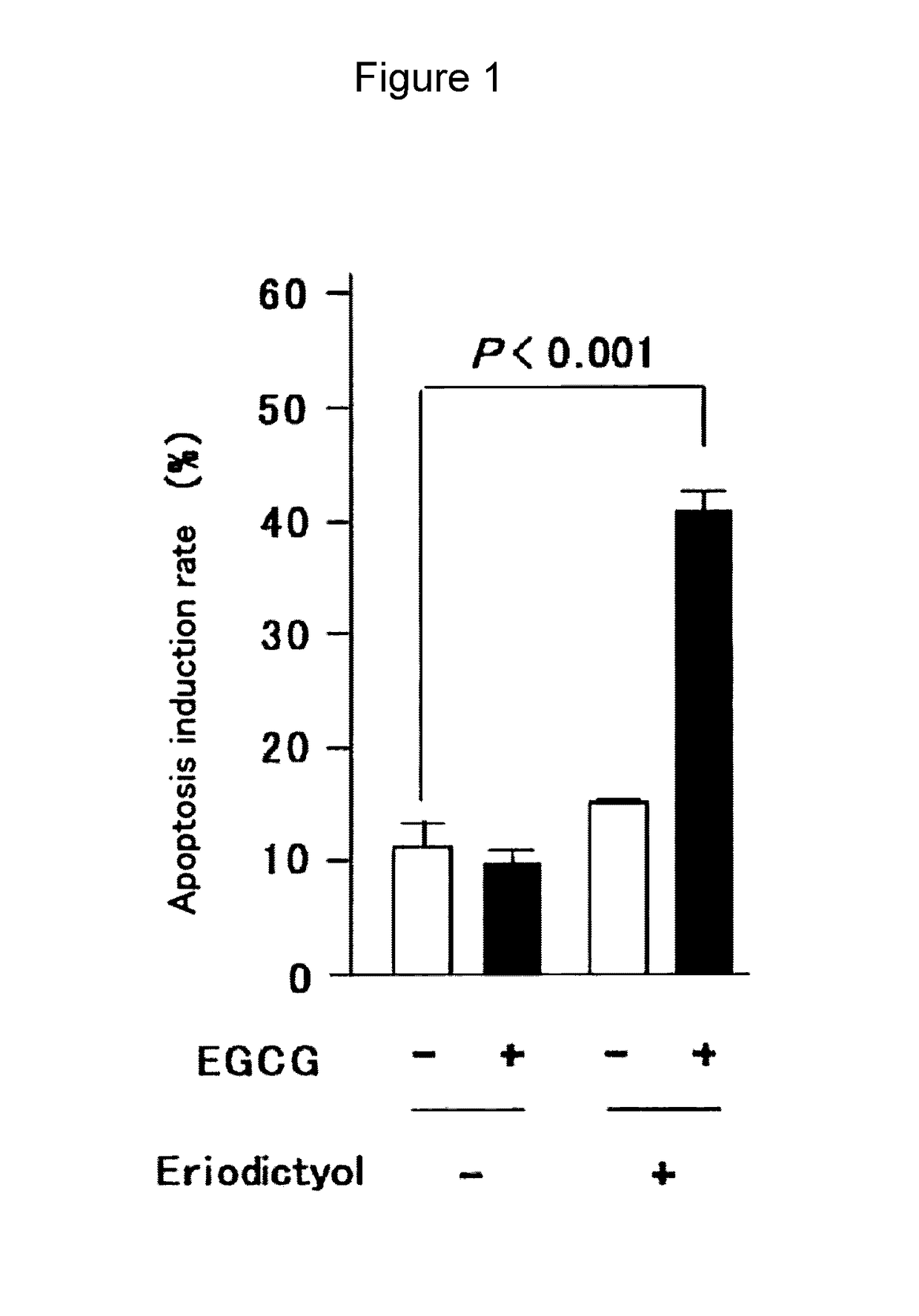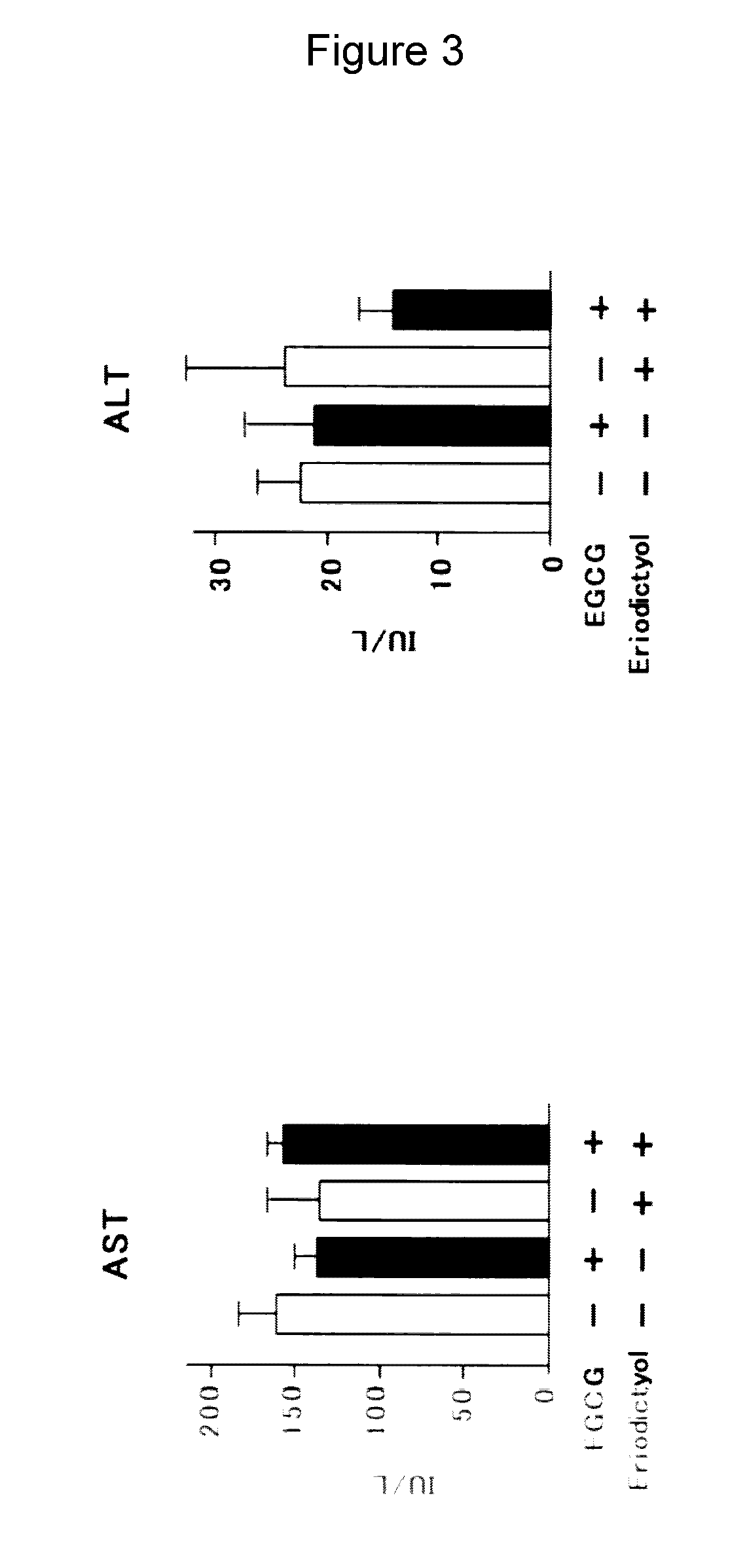Catechin function enhancement method
a technology of functional enhancement and catechin, which is applied in the field of functional food products, can solve the problems of limited effect of egcg on leukemia cells or multiple myeloma cells
- Summary
- Abstract
- Description
- Claims
- Application Information
AI Technical Summary
Benefits of technology
Problems solved by technology
Method used
Image
Examples
example 1
[0144]Effect of Combination with Eriodictyol on the Cancer Cell Apoptosis Induction Effect of EGCG (FIG. 1)
[0145]To evaluate the effect of eriodictyol on the cancer cell apoptosis induction effect of EGCG, human multiple myeloma cell line U266 was adjusted to 5×104 cells / mL and seeded in a 96-well plate, and then cultured for 96 hours in the presence of EGCG and eriodictyol added at a final concentration of 5 μM each. After culture for 96 hours, the Annexin V Alexa Fluor 488 conjugate (Invitrogen) was added in a volume of 5 μL. The PI stain solution (2 μL) was added and the cells were allowed to stand at room temperature for 15 minutes. Then, the Annexin V binding buffer (400 μL) was added and the number of cells where apoptosis was induced was measured with a flow cytometer.
[0146]As a result, eriodictyol was found to enhance the apoptosis induction effect of EGCG.
example 2
Anticancer Effect in Tumor-Implanted Mice Upon Combined Use of EGCG and Eriodictyol (FIG. 2)
[0147]To evaluate the anticancer effect upon combination of EGCG and eriodictyol, Balb / c mice were preliminarily kept for 2 weeks and a cell suspension of mouse multiple myeloma cell line MPC-11 suspended at 5×106 cells / mL in RPMI medium was then subcutaneously injected into the right dorsal region of each mouse. After confirmation of tumor engraftment, the mice were administered once every 2 days with EGCG (15 mg / kg i.p.) and eriodictyol (15 mg / kg i.p.) and measured for their tumor volume. As a result, the combined use of eriodictyol and EGCG was found not only to remarkably inhibit tumor growth, but also to significantly prolong the survival period.
example 3
Hepatotoxicity in Tumor-Implanted Mice Upon Combination of EGCG and Eriodictyol (FIG. 3)
[0148]Mice which had been implanted with mouse multiple myeloma cell line MPC-11 were administered once every 2 days with EGCG (15 mg / kg i.p.) and eriodictyol (15 mg / kg i.p.). The mice were sacrificed and measured for their serum aspartate aminotransferase (AST) and alanine aminotransferase (ALT) activities.
[0149]As a result, the combination of EGCG and eriodictyol did not induce increases in AST and ALT levels, thus indicating that this combination showed no hepatotoxicity.
PUM
| Property | Measurement | Unit |
|---|---|---|
| temperature | aaaaa | aaaaa |
| temperature | aaaaa | aaaaa |
| concentration | aaaaa | aaaaa |
Abstract
Description
Claims
Application Information
 Login to View More
Login to View More - R&D
- Intellectual Property
- Life Sciences
- Materials
- Tech Scout
- Unparalleled Data Quality
- Higher Quality Content
- 60% Fewer Hallucinations
Browse by: Latest US Patents, China's latest patents, Technical Efficacy Thesaurus, Application Domain, Technology Topic, Popular Technical Reports.
© 2025 PatSnap. All rights reserved.Legal|Privacy policy|Modern Slavery Act Transparency Statement|Sitemap|About US| Contact US: help@patsnap.com



